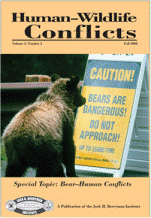Wildlife Damage Management, Internet Center for
Date of this Version
Spring 2009
Abstract
This paper provides an overview of the predatory activities of the house cat (Felis catus) in Australia, focusing principally on the interactions of domestic and stray cats with native species of prey. Like their free-living, or feral, counterparts, domestic cats take a broad range of prey, with small mammals, birds, and human-derived foods forming the bulk of the diet. Domestic and stray cats have contributed to declines of suburban populations of eastern barred bandicoots (Perameles gunnii) and superb lyrebirds (Menura novaehollandiae) in Victoria, Australia. The effects of cats on prey communities remain speculative. In Sydney, artificial nests placed in trees in forest remnants suffered less predation where cat activity was high rather than where it was low, indicating that cats beneficially reduced damage by introduced rats and other nest predators. However, high cat activity was associated with reduced bird diversity. Legislation to encourage responsible cat ownership has been passed in Australia; it should have positive outcomes for both wildlife conservation and cat welfare.


Comments
Published in Human–Wildlife Conflicts 3(1):41–48, Spring 2009. Published and copyright by Jack H. Berryman Institute http://www.berrymaninstitute.org/journal/index.html